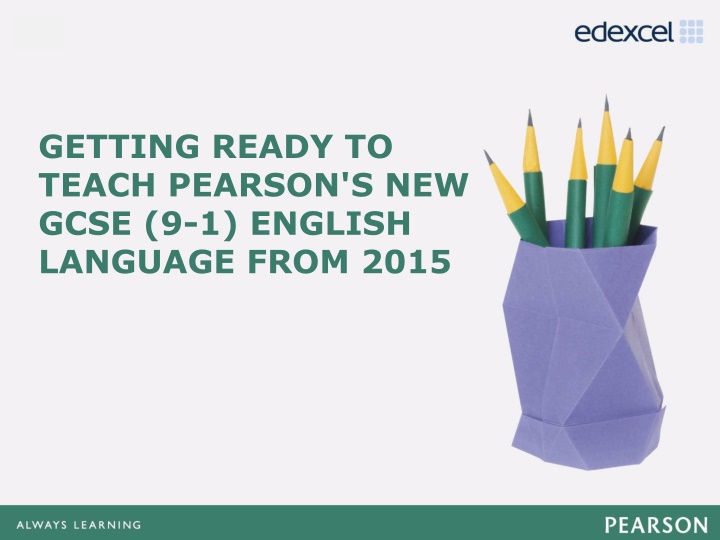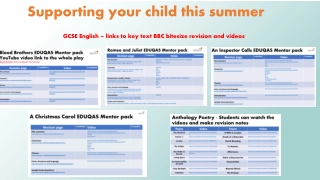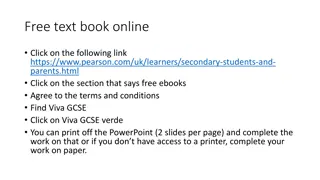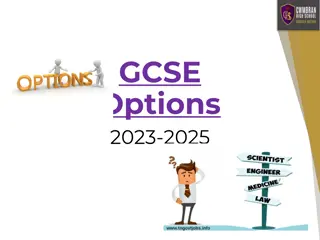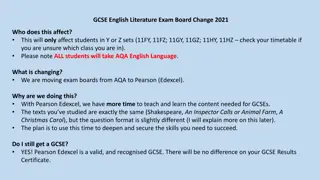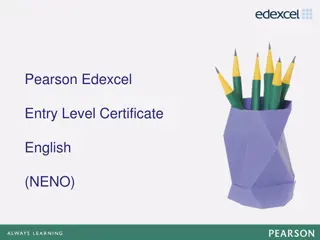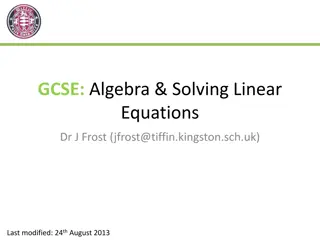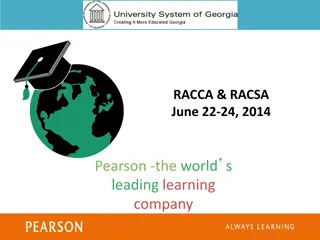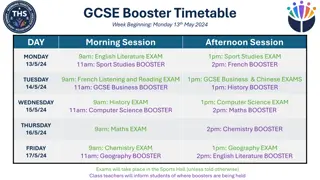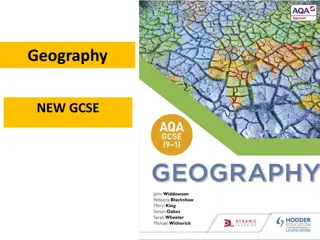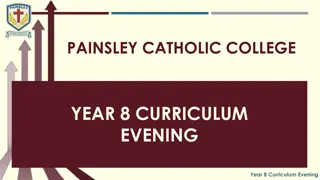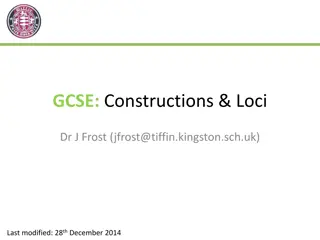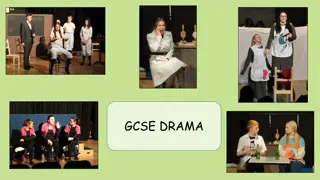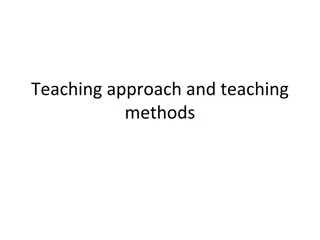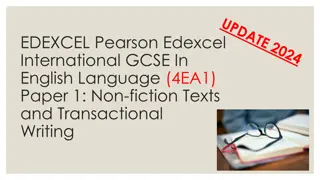Teaching Pearson's New GCSE English (9-1)
In preparation for teaching Pearson's new GCSE English Language from 2015, this content covers the specification overview, changes to subject criteria including fiction writing and reading distribution, as well as details on the Spoken Language endorsement assessment. The requirements, assessment objectives, and levels of achievement for the Spoken Language endorsement are outlined, along with information on how spoken language assessments are conducted externally or internally.
Download Presentation

Please find below an Image/Link to download the presentation.
The content on the website is provided AS IS for your information and personal use only. It may not be sold, licensed, or shared on other websites without obtaining consent from the author.If you encounter any issues during the download, it is possible that the publisher has removed the file from their server.
You are allowed to download the files provided on this website for personal or commercial use, subject to the condition that they are used lawfully. All files are the property of their respective owners.
The content on the website is provided AS IS for your information and personal use only. It may not be sold, licensed, or shared on other websites without obtaining consent from the author.
E N D
Presentation Transcript
Click to edit Master title style GETTING READY TO TEACH PEARSON'S NEW GCSE (9-1) ENGLISH Click to edit Master text styles Second level Third level Fourth level Fifth level LANGUAGE FROM 2015
Click to edit Master title style Click to edit Master text styles Second level Third level Fourth level Fifth level SPECIFICATION OVERVIEW
Changes to subject criteria Click to edit Master title style GCSE English Language Click to edit Master text styles Second level Third level Fourth level Fifth level fiction Writing - 50% of the GCSE Reading - 50% of the GCSE Students are required to answer questions on unseen 19th, 20th and 21stcentury texts These texts must cover fiction, non-fiction and literary non- SPaG has an increased weighting of 20% Minimum examination time of 3.5 hours.
Changes to subject criteria Click to edit Master title style Spoken Language endorsement Spoken Language is assessed as a separate endorsement Click to edit Master text styles Second level Third level Fourth level Fifth level Awarding Body for moderation Students will be required to present to an audience on a topic of their choice and listen to, and answer, questions Students presentations will be audio recorded and sent to the There are 2 assessment objectives: AO7 Demonstrate presentation skills in a formal setting. AO8 Listen and respond appropriately to spoken language, including to questions and feedback to presentations.
Spoken Language endorsement cont Click to edit Master title style Spoken language assessments will be assessed by teachers (with provision for students to be directly assessed by the exam boards where desirable or necessary) using a set of criteria that are common across all exam boards. Click to edit Master text styles Second level Third level Fourth level Fifth level A student must meet all of the criteria in relation to a level to be awarded that level. There will be three levels of achievement, Pass , Merit and Distinction , and one outcome indicating the required standard was not met. This will be called Not Classified . Spoken language assessments may be externally assessed by exam boards and/or internally assessed by teachers, using criteria set by Ofqual. Exam boards will monitor the assessment of spoken language where this is undertaken by teachers by requiring schools to submit audio-visual recordings of a sample of their students.
Click to edit Master title style Specification Overview Students will be able to: Read a wide range of texts fluently and with good understanding Click to edit Master text styles Second level Third level Fourth level Fifth level Read critically and use knowledge gained from wide reading to inform and improve their own writing Write effectively and coherently using Standard English appropriately Use grammar correctly, punctuate and spell accurately
Click to edit Master title style Specification Overview Click to edit Master text styles Second level Third level Fourth level Fifth level knowledge and understanding of grammatical terminology, and linguistic conventions for reading, writing and spoken language Listen to and understand spoken language, and use spoken Standard English effectively. Students will be able to: Acquire and apply a wide vocabulary alongside
Click to edit Master title style Click to edit Master text styles Second level Third level Fourth level Fifth level KEY FEATURES AND FEEDBACK FROM LAUNCH
Click to edit Master title style Paper 1 Overview Click to edit Master text styles Second level Third level Fourth level Fifth level The focus of this component is: Section A Reading: study and analyse selections from a range of prose fiction. Section B Imaginative Writing: explore and develop imaginative writing skills. Fiction and Imaginative Writing
Click to edit Master title style Paper 2 Overview Click to edit Master text styles Second level Third level Fourth level Fifth level The focus of this component is: Section A Reading: study and analyse selections from a range of non-fiction texts (including literary non-fiction) Section B Transactional writing: explore and develop transactional writing skills, for example letters, articles, reports. Non-Fiction and Transactional Writing
GCSE English Language Click to edit Master title style Paper 1 1 hr 45 mins (40%) Section A: Unseen 19thCentury fiction Extract will be approximately 650 words in length Shorter response questions will focus on close analysis of the text; longer response questions will ask students to show their understanding of the whole text Paper 2 2 hrs (60%) Section A: Comparison of two unseen texts from the 20thand 21stcentury One non-fiction; one literary non-fiction Extracts will be approximately 1000 words in total Shorter response questions will focus on close reading of the texts; longer response questions will ask students to compare the texts Click to edit Master text styles Second level Third level Fourth level Fifth level Section B: Creative Writing Choice of 2 tasks linked to the theme of the 19thcentury fiction One task will include images to help students address the task Audience and purpose along with SPaG will be assessed Section B: Transactional writing Choice of 2 tasks linked to the theme of the texts Newspaper articles, letters etc Audience and purpose along with SPaG will be assessed
Click to edit Master title style Key Features The 19th century requirement will always be met via one stand-alone fiction text Click to edit Master text styles Second level Third level Fourth level Fifth level English Literature. This provides additional exposure to the sorts of literary heritage texts students will encounter in It will be straightforward for you to find similar texts for teaching and learning.
Click to edit Master title style Key Features Comparison of modern non-fiction texts This ensures comparison is not limited to differences in language between older and more contemporary texts. Click to edit Master text styles Second level Third level Fourth level Fifth level Students will be able to develop the skills required to analyse real-world, relevant non- fiction texts of a sort they will encounter in their lives. Again, it will be straightforward for you to find similar texts for teaching and learning.
Click to edit Master title style Key Features Clear, straightforward paper structure Click to edit Master text styles Second level Third level Fourth level Fifth level additional work (comparison, two reading texts) expected of learners in this paper. Paper 1 = fiction/creative writing Paper 2 = non-fiction/transactional writing The higher weighting for Paper 2 reflects the
Click to edit Master title style Key Features Clear, straightforward timings. Click to edit Master text styles Second level Third level Fourth level Fifth level Paper 1 timings as a very rough guide are 1 hour for the reading section and 40-45 minutes for the writing section. There are more questions overall, however there are more short answer questions. Paper 2 timings as a very rough guide are 1 hour 15 minutes for the reading section and 40-45 for the writing section.
Click to edit Master title style Key Features Reading and Writing linked Click to edit Master text styles Second level Third level Fourth level Fifth level A choice of writing tasks per paper. Papers linked by a theme: reading provides students with a stimulus and a model for their writing. An optional set of images to provide an additional stimulus for learners in the imaginative writing section.
Click to edit Master title style Click to edit Master text styles Second level Third level Fourth level Fifth level WORKING WITH AN UNTIERED EXAM
Click to edit Master title style Inclusive and accessible Click to edit Master text styles Second level Third level Fourth level Fifth level Shorter answer questions start each paper and target specific skills linked to comprehension: providing facts, locating answers, identifying information, describing, giving examples, summarising, identifying purpose In the assessment objectives this is AO1. Ramping questions move upwards in requirements and marks, but all students can read and understand them.
GCSE English Language Click to edit Master title style Assessment objectives for Reading Click to edit Master text styles Second level Third level Fourth level Fifth level texts AO2 Explain, comment on and analyse how writers use language and structure to achieve effects and influence readers, using relevant subject terminology to support their views AO3 Compare writers ideas and perspectives, as well as how these are conveyed, across two or more texts AO4 Evaluate texts critically and support this with appropriate textual references AO Assessment objective % in GCSE AO1 Identify and interpret explicit and implicit information and ideas Select and synthesise evidence from different 7.5 15 8.75 18.75
Inclusive and accessible Click to edit Master title style Paper 1 Q2: From lines 13-19, give two ways the narrator s behaviour shows that he is confident he will not be caught. Click to edit Master text styles Second level Third level Fourth level Fifth level perfect triumph' Question 2 1. 'I smiled, for what had I to fear' 2. 'wild audacity of my Mark Comments 2 This candidate gives two quotations to answer the question which is acceptable. 1. Covered up the evidence by placing a chair on top of the corpse He was confident. Not insecure. He smiled and welcomed the gentlemen into his home. He showed the men around and sat down with them. 1 This answer achieves one mark for the first point but the second is not specific enough to achieve a mark. 2. 1. 2 This candidate has used their own words to answer the question which is acceptable. The first answer could be credited as two points (smiled and welcomed). 2.
Inclusive and accessible Click to edit Master title style Paper 2 Q1 : In lines 41-49, identify two requirements needed by people to be recruited by MI6 (SIS). Click to edit Master text styles Second level Third level Fourth level Fifth level Motivated problem solvers who do not crave the limelight People who are good at building relationships Question 1 1. Applicants must be British 2. Must also hold a 2:2 degree or above Mark Comments Two correct answers offered. 2 1. 2 Two correct answers offered. 2. 1. 2. Online application Assessment course 0 Both answers are incorrect as they look at what people need to do rather than have. 1. 2. Assessment Must be British and hold a 2:2 degree or above. 2 While the first answer is incorrect, two correct answers are given in the second part.
Click to edit Master title style Click to edit Master text styles Second level Third level Fourth level Fifth level PLANNING FOR TEACHING, LEARNING AND ASSESSMENT
GCSE English Language Click to edit Master title style Assessment objectives for Reading Click to edit Master text styles Second level Third level Fourth level Fifth level AO2 Explain, comment on and analyse how writers use language and structure to achieve effects and influence readers, using relevant subject terminology to support their views AO3 Compare writers ideas and perspectives, as well as how these are conveyed, across two or more texts AO4 Evaluate texts critically and support this with appropriate textual references AO Assessment objective % in GCSE AO1 Identify and interpret explicit and implicit information and ideas Select and synthesise evidence from different texts 7.5 15 8.75 18.75
AO2 Achievement an extract Paper 1 Q3: In lines 20-25, how does the writer use Click to edit Master title style language and structure to show the change in the narrator s mood? Click to edit Master text styles Second level Third level Fourth level Fifth level story. At the end of this particular paragraph then sentences have become considerably and noticeably longer to those at the beginning. The longer sentences are constructed through the use of colons, hyphens and embedded clauses. Using this punctuation the writer has been able to include large amounts of information in a single sentence, showing a stream of consciousness. This results in a hectic - almost dizzying - finish to the paragraph as the narrator's mind becomes confused and taken over by paranoia. Using the superlative 'more' Allan Poe is able to add to the change in mood he wishes to create. Allan Poe doesn't just use word choice to create an atmosphere. As mentioned before his sentence structure is crucial to his set up towards the crux of the
What is evaluation? Click to edit Master title style Questions on both papers will ask students to evaluate how well the writer achieves something (e.g. creating tension) for AO4. In exemplar responses the greatest issue was students producing an AO2 answer: Click to edit Master text styles Second level Third level Fourth level Fifth level 1. focus on how well , not how 2. use evaluative language opinion, judgement 3. focus on ideas, events, themes and settings.
Level 1 Evaluation Click to edit Master title style Paper 1 Q4: In this extract, there is an attempt to build tension. Evaluate how successfully this is achieved. Support your views with detailed reference to the text Click to edit Master text styles Second level Third level Fourth level Fifth level starting section is really the one where he builds tension. He leaves you wanting to know more because of not giving all the information. I think he builds tension well. Although the
AO4 Achievement an extract Paper 1 Q4:In this extract, there is an attempt to build tension. Evaluate Click to edit Master title style how successfully this is achieved. Support your views with detailed reference to the text Click to edit Master text styles Second level Third level Fourth level Fifth level develops tension. The language used avoids description of whatever is being hidden, and because of this the reader feels a sense of intrigue initially. He writes 'deposited all between the scantlings', but 'all' is not specific. The use of the narrator's reflection on how well he has done to hide the item moves the reader from intrigue to concern. Because he uses the adverbs 'cleverly' and 'cunningly' the reader is manipulated into thinking that he is deliberately trying to conceal the item from someone else. The confirmation of the idea that something is wrong is seen in the use of 'wrong' at the end of the sentence. At this point the reader's tension has been built through the themes of intrigue and concern about what he has done The theme of the extract is hiding a secret and the guilt that this can lead to. Because of this the tension is developed through the piece, and very quickly builds up in a short space of time. Since the tension is so condensed it has more effect. The idea of a secret is shown at the start of the extract and the way that this is described by the writer
Synthesis Click to edit Master title style This final element of AO1 is assessed through a discrete question in Paper 2- 7a) Students need to draw information from both texts. This is not a comparison (AO3) as students select explicit information from both texts. Click to edit Master text styles Second level Third level Fourth level Fifth level
AO1 Synthesis an extract Paper 2 Q7a):The two texts show the points of view of different Click to edit Master title style spies. What similarities do the spies Nick and Leo share in these texts? Use evidence from both texts to support your answer. Click to edit Master text styles Second level Third level Fourth level Fifth level long time. Nick says that occasionally working for MI6 you 'do work long hours' and Leo has to spend more than three days on the code in the extract. Both Leo and Nick have been educated and are clever. Nick was the first one from his family to go to university and Leo shows that he knows what he is talking about through the language he uses like 'substitution code' and 'frequency count In the two texts there are many similarities between the two spies. Both spies have to work very hard for a
Comparison Click to edit Master title style Comparison of two texts has been a key part of the current GCSE The comparison will feature in paper 2 and Click to edit Master text styles Second level Third level Fourth level Fifth level will therefore be on the non-fiction texts Ideas, perspectives, language, structure It will be the final question as by then candidates will have selected and synthesised, examined language and structure and evaluated texts they will know the texts very well.
AO3 Comparison an extract Click to edit Master title style Paper 2 Q7b): Compare how the writers of Text 1 and Text 2 present their ideas and perspectives about intelligence agency work. Click to edit Master text styles Second level Third level Fourth level Fifth level 'building relationships'. Text 2 shows that breaking the code is a team effort with Leo and the girls working together, even though they don't get along. The texts are different in the way that the spies talk about their work. Nick and Catherine talk positively about their experiences - Nick says it is friendly and flexible 'I do get to drop my daughter at nursery' and Catherine says that it is safe. Leo on the other hand uses negative language to reflect his experience like 'unbreakable', tedious' and 'slogging Both texts are similar in that they show that there is a need to be part of a team. Text 1 says 'he was 'amazed' how friendly it was', showing that the work means you get to be part of working with people. It also says that you have to be good at
GCSE English Language Click to edit Master title style Assessment objectives for Writing Click to edit Master text styles Second level Third level Fourth level Fifth level forms, purposes and audiences AO Assessment objective % in GCSE AO5 Communicate clearly, effectively and imaginatively, selecting and adapting tone, style and register for different 30 Organise information and ideas, using structural and grammatical features to support coherence and cohesion of texts Candidates must use a range of vocabulary and sentence structures for clarity, purpose and effect, with accurate spelling and punctuation AO6 20
Imaginative Writing an Click to edit Master title style extract Paper 1 Q5: Write about a time when you, or someone you know, tried to hide something. Your response could be real or imagined. Click to edit Master text styles Second level Third level Fourth level Fifth level Charlotte had both started talking to him online. We knew who he was he went to our school. I started talking to him first after he gave me a cheeky smile in town. Hey x I typed on the keyboard: I pressed enter to send. I remember smiling as it said read 4:53pm . That s how me and Oscar started talking. We got to know each other and it wasn t until a couple of months later Charlotte got involved I was stuck in the middle. Charlotte was my best friend and Oscar was the boy I really like. Me and
Transactional Writing an extract Paper 2 Q8: Write a letter to MI6, applying for a position as an Click to edit Master title style Intelligence Officer. I am a highly qualified criminologist with qualifications important for your work. I have sophisticated communication skills, demonstrated through my A Level in English Language but also Click to edit Master text styles Second level Third level Fourth level Fifth level through my day-to-day dealings with a range of clients and customers. I am proficient in both speaking and listening, and skilled at picking up nuances of what people are saying and analysing sub-text. I also have an A Level in Psychology, making me suitable for interrogations with foes. Secondly I spent three years at university earning a First in Criminology and Forensic Science
Click to edit Master title style Click to edit Master text styles Second level Third level Fourth level Fifth level KEY CONCERNS AND OUR SUPPORT
Understanding the standard Click to edit Master title style Additional sample papers Schemes of work and course planners Key Stage 3 tests for Year 7 (baseline on Click to edit Master text styles Second level Third level Fourth level Fifth level entry), Year 7 end of year, Year 8 end of year and Year 9 end of year Grammar for Writing and Let s Think in English.
Our Website Click to edit Master title style Click to edit Master text styles Second level Third level Fourth level Fifth level
Understanding the standard Click to edit Master title style Extensive training for all units Training on delivering units and marking mocks Click to edit Master text styles Second level Third level Fourth level Fifth level Local network groups Local support team Subject advisor.
Planning and SoW Click to edit Master title style Option for a 2 year plan year 10 Click to edit Master text styles Second level Third level Fourth level Fifth level Autumn 2 Reading and Writing skills Year 10 Language Literature Autumn 1 Intro to Language AOs Intro to Literature AOs Shakespeare play Spring 1 AO3 comparison writing skills Post-1914 text introduction Spring 2 Mock exam Post-1914 text reading the whole text Summer 1 Reading Skills 19th century. 19th-century text Summer 2 Imaginative writing Introduction to poetry anthology and unseen
Planning and SoW Click to edit Master title style Option for a 2 year plan year 11 Click to edit Master text styles Second level Third level Fourth level Fifth level Autumn 2 Year 10 Language Literature Autumn 1 Reading and Writing non- fiction Poetry Revisit Shakespeare play Spring 1 Revise Language Paper 1 Revise Literature Paper 1 Spring 2 Revise Language Paper 2 Revise Literature Paper 2 Summer 1 Revision focus on timings and SAMs Exam Revision focus on timings and SAMs Exam Summer 2
Click to edit Master title style Teaching and Learning Click to edit Master text styles Second level Third level Fourth level Fifth level evidence-based pedagogies Specifically designed to help overcome critical barriers to progress in the 11-19 English curriculum Providing you with free teaching support based on these pedagogies We are teaming with academic partners University of Exeter and Kings College London Creating powerful support built around trialled,
Click to edit Master title style Grammar for Writing Click to edit Master text styles Second level Third level Fourth level Fifth level contextualised grammar had a statistically significant impact on reading and writing In partnership with Debra Myhill and University of Exeter Recent study at KS4 showed teaching Positive impact on language analysis, sentence structure, punctuation and spelling Impact was measured using new Edexcel GCSE Language SAMs, and results were marked by Edexcel examiners
Grammar for Writing Free Click to edit Master title style unit of work Free lesson support for you to put the pedagogy into practice 1 unit of work, comprised of 9 lessons Click to edit Master text styles Second level Third level Fourth level Fifth level Lesson plans, Powerpoints, Worksheets, other assets Developed by Debra Myhill and her team Trialled and reviewed content Available NOW online via ActiveTeach, for front- of-class use or easy download
Click to edit Master title style Grammar for Writing Click to edit Master text styles Second level Third level Fourth level Fifth level Lesson plan, PowerPoints and worksheets can be downloaded or launched straight from the website
Grammar for Writing Live Click to edit Master title style exam reports Click to edit Master text styles Second level Third level Fourth level Fifth level analysing: Reporting on students use of SPaG in exams Debra and her team will be assessing live student exam scripts and writing a report Grammatical aspects of student writing at sentence level Paragraph and textual organisation Composition and effect Reports will help teachers to pinpoint areas of concern First report available now, based on June 2014 exam series
Click to edit Master title style Let s Think in English Click to edit Master text styles Second level Third level Fourth level Fifth level Pedagogy underpinned by a research trial Helps students develop thinking skills necessary for success in English In partnership with Kings College London Teaching programme developed by a team at Kings College London Builds skills of inference, deduction and analysis Builds confidence in unseen texts in exams Lessons are based on discussion, problem solving and structured reflection
Lets Think in English Free Click to edit Master title style lessons Free support to put the pedagogy into practice 5 free lessons Click to edit Master text styles Second level Third level Fourth level Fifth level Lessons based on text types for the new GCSEs: Lesson plans, Powerpoints, Worksheets, other assets Developed, trialled and reviewed by Kings College London 19thcentury fiction 20thcentury literary non-fiction Modern direct non-fiction Romantic poetry Shakespeare Available NOW online via ActiveTeach, for front- of-class use or easy download
Click to edit Master title style Let s Think in English Click to edit Master text styles Second level Third level Fourth level Fifth level Lesson plan, PowerPoints and worksheets can be downloaded or launched straight from the website
KS3 Support GCSE-style Click to edit Master title style assessments We are providing GCSE-style assessments opportunities for KS3 End of year assessments in years 7, 8 and 9 in both Language and Literature Baseline assessment for the start of year 7 in both Language and Literature One free unit of Grammar for Writing for Y9 Click to edit Master text styles Second level Third level Fourth level Fifth level
KS3 Support GCSE-style Click to edit Master title style assessments Click to edit Master text styles Second level Third level Fourth level Fifth level appropriate for the year group, with relevant skills/AOs assessed at the appropriate level The KS3 GCSE-style assessments will: Will progress towards the format of the GCSE exams Focus on ensuring the level of the assessment will be Be linked to the Pearson Progression Steps to help you to track progress Move towards being assessed using the GCSE mark scheme Be paper-based, downloadable, printable question papers and mark schemes
